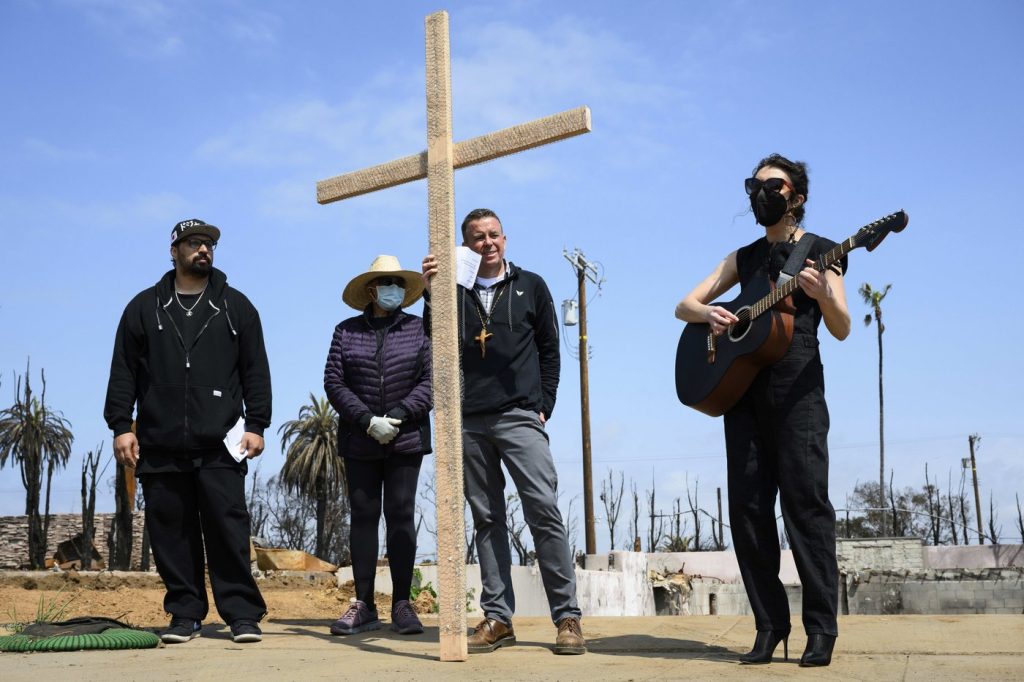LOS ANGELES (AP) — Pastor John Shaver, bearing a tall wooden cross on his shoulder, walked along the street where the Community United Methodist Church of Pacific Palisades had stood until it was engulfed by wildfire in January. This church was a pillar in the community for over a century but was lost in flames that decimated many homes and lives, including nearly 80% of the congregation, who faced the tragedy of losing their homes.
Three months post-fire, Shaver and a small group of church members gathered on Good Friday at the scorched remains of their beloved church. Amid the cacophony of construction equipment preparing the site for rebuilding, they participated in a “cross walk,” pausing at nine stations to read Bible verses linked to the events of Jesus' last day. This ritual was a departure from the traditional 14 steps that typically commemorate Christ's suffering.
As they walked, the group reflected on both their loss and the enduring hope of Easter. Christine Odionu, a church member, visited her burnt condo, where only the garage remained. The emotional weight of loss was palpable as she remarked, “It’s just too painful,” underscoring the juxtaposition of sorrow and the hopeful promise that Easter brings.
Another church member, Annette Rossilli, was among the 29 fatalities across Los Angeles due to the wildfires fueled by dry conditions and strong winds that erupted on January 7. Pastor Shaver, reflecting on this communal loss, visited the site of his own home, recalling cherished memories and heirlooms lost to the flames. He emphasized the lesson learned through the tragedy: “It’s also a reminder how much of what we have, we take for granted.” On that day, Shaver wore clothes donated to him, honoring the spirit of appreciation and resilience.
The atmosphere on Via De La Paz, where the church once thrived, was filled with the sounds of rebuilding. Demolition crews cleared the aftermath of destruction, revealing eerie remnants of lives once lived, like charred palm trees and twisted metal. Yet, hope was represented in blue signs homeowners erected, proclaiming, “This home will rise again,” as well as messages from Palisades Elementary Charter School stating, “Pali will rebuild.”
Thomas Knoll, a neighbor who also lost his home, articulated the sentiment many felt: “This feels like sort of a funeral for Pacific Palisades.” The powerful symbolism of crucifixion and resurrection resonated deeply, as the community recognized the arduous journey ahead in rebuilding their town. The founders of the church, who contributed to the development of Pacific Palisades, had established it as a community center for cultural and educational activities as far back as its inception in 1922. These traditions continued until the fire, where the church served as a gathering space for various community events.
Despite the significant losses, Shaver revealed that some items were salvaged from the ashes, including ceramic tiles and a large metal cross that once graced the church's tower. A stone cross also survived, offering a tangible connection to their past. In a poignant moment, congregant Adriana Ruhman sifted through debris, discovering a tile imprinted with her children's handprints from their time in preschool, which she described as “hitting the jackpot.” This discovery brought her hope amidst overwhelming grief.
Mary Katherine Breland, a longtime attendee, expressed her emotional struggle upon returning to the site for the first time after the disaster. She articulated the need for the community to regroup and find strength through their faith and shared memories as they forge ahead. Pastor Shaver, recognizing the significance of the day, stated that the Good Friday cross walk was a new tradition he hoped to continue in the future. Upon reaching the scenic bluffs overlooking the Pacific, the group found a view that symbolized new beginnings rather than endings.
As the cross they bore remained bare on Good Friday, Shaver’s vision for Easter Sunday included adorning it with fresh flowers as a representation of their rebirth as a congregation, solidifying the belief that the fire marked not an end, but the start of a renewed journey for the community.










